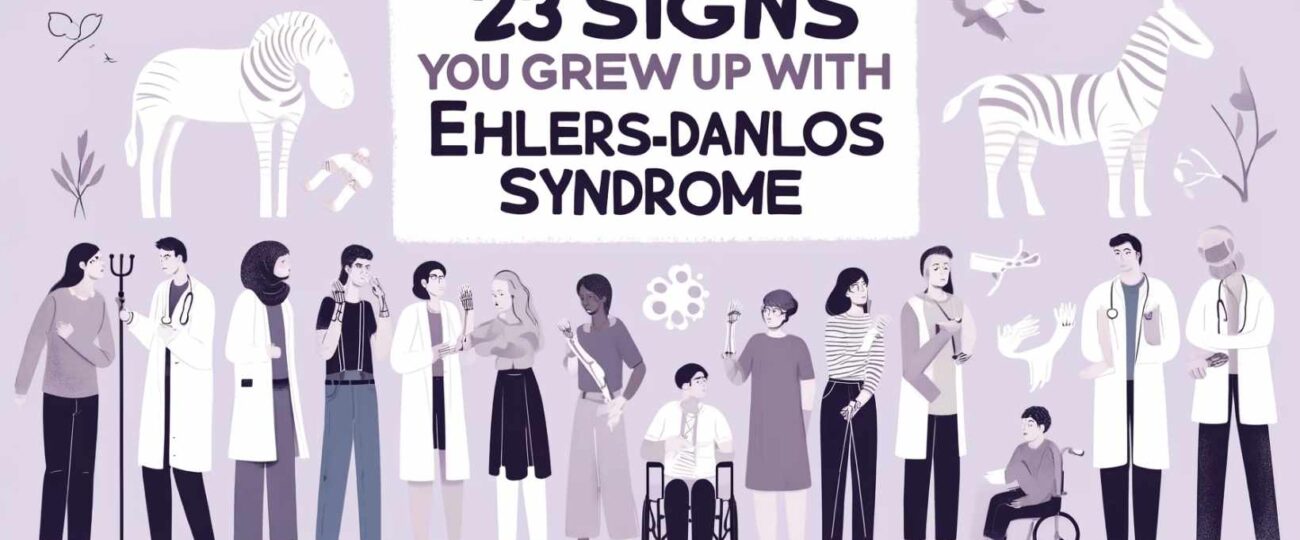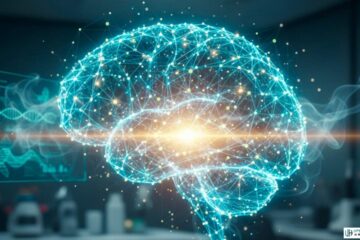Growing up with Ehlers-Danlos Syndrome (EDS) often means navigating a world that doesn’t quite understand your experiences. From unexplained joint pain to frequent injuries, many signs of EDS can be mistaken for clumsiness or overexertion. This article explores 23 signs you grew up with Ehlers-Danlos Syndrome. It sheds light on the challenges and resilience that come with this condition.
What Is Ehlers-Danlos Syndrome (EDS)?
Ehlers-Danlos Syndrome is a group of genetic connective tissue disorders characterized by joint hypermobility, skin hyperextensibility, and tissue fragility. According to the Ehlers-Danlos Society, there are 13 subtypes of EDS, each with its own set of symptoms. The most common type is hypermobile EDS (hEDS), which often goes undiagnosed due to its subtle and varied symptoms.
23 Signs You Grew Up With Ehlers-Danlos Syndrome
- Hypermobile Joints
- Frequent Joint Dislocations or Subluxations
- Chronic Joint and Muscle Pain
- Soft, Stretchy Skin
- Easy Bruising
- Delayed Wound Healing and Scarring
- Fatigue and Low Energy Levels
- Frequent Headaches or Migraines
- Gastrointestinal Issues
- Dizziness and Fainting
- Poor Proprioception and Clumsiness
- Dental and Oral Health Challenges
- Vision Problems
- Anxiety and Depression
- Sensitivity to Temperature Changes
- Difficulty with Physical Activities
- Sleep Disturbances
- Bladder and Pelvic Floor Issues
- Allergies and Sensitivities
- Family History of Similar Symptoms
- Struggles with Misdiagnosis
- Need for Assistive Devices
- Resilience and Adaptability
1. Hypermobile Joints
Did you ever impress your friends with your flexibility? Could you bend your thumb to your wrist? Or maybe you did the splits effortlessly? While it might have seemed like a cool party trick, hypermobility is a hallmark of EDS. This excessive flexibility can lead to joint instability and increased risk of injuries.
2. Frequent Joint Dislocations or Subluxations
If your joints frequently popped out of place during everyday activities, it could be a sign of EDS. Subluxations (partial dislocations) and full dislocations are common due to the laxity of connective tissues supporting the joints.
3. Chronic Joint and Muscle Pain
Persistent pain in joints and muscles, even without significant physical activity, is a common complaint among those with EDS. This pain can start in childhood and often continues into adulthood, affecting daily functioning.
4. Soft, Stretchy Skin
Having soft, velvety skin that stretches more than usual is another indicator. While it might have seemed like a unique trait, this skin elasticity is due to the defective collagen in EDS.
5. Easy Bruising
Did you often find bruises on your body without recalling any injury? Fragile blood vessels in EDS patients can lead to easy bruising, even from minor bumps or pressure.
6. Delayed Wound Healing and Scarring
If your cuts took longer to heal and left thin, papery scars, it might be linked to EDS. The compromised connective tissue affects the skin’s ability to repair itself efficiently.
7. Fatigue and Low Energy Levels
Chronic fatigue is a common yet often overlooked symptom. The constant effort to stabilize joints and manage pain can drain energy, leading to persistent tiredness.
8. Frequent Headaches or Migraines
Many with EDS experience regular headaches or migraines. These can sometimes result from cervical spine instability. Other vascular issues associated with the syndrome can also cause them.
9. Gastrointestinal Issues
Digestive problems like irritable bowel syndrome (IBS), acid reflux, or bloating are prevalent. These issues stem from the connective tissue abnormalities affecting the gastrointestinal tract.
10. Dizziness and Fainting
Experiencing lightheadedness or fainting upon standing could be related to orthostatic intolerance. It may also be due to Postural Orthostatic Tachycardia Syndrome (POTS). These conditions are commonly associated with EDS.
11. Poor Proprioception and Clumsiness
If you often bumped into things or had trouble with coordination, it might not have been mere clumsiness. EDS can impair proprioception, the sense of body position, leading to balance issues.
12. Dental and Oral Health Challenges
Growing up with Ehlers-Danlos Syndrome (EDS) often means facing unique dental and oral health challenges. The connective tissue abnormalities inherent in EDS can lead to a variety of issues affecting the mouth, teeth, and jaw.
One common concern is the fragility of oral tissues. Individuals with EDS may experience easily bruised or torn gums, making routine dental procedures more complicated and recovery times longer. This tissue fragility can also contribute to periodontal disease, as the gums are more susceptible to inflammation and infection.

Tooth enamel abnormalities are another issue. Weakened enamel can lead to increased tooth sensitivity, a higher risk of cavities, and dental erosion. Additionally, individuals with EDS may experience dental crowding or misalignment due to the laxity of connective tissues supporting the teeth.
Temporomandibular joint (TMJ) disorders are also prevalent among those with EDS. The joint connecting the jawbone to the skull can become unstable. This leads to pain, clicking or popping sounds, and difficulty in jaw movement.
13. Vision Problems
If you experienced frequent eye strain, nearsightedness, or other vision issues, it might be linked to EDS. Individuals with EDS can have ocular complications due to the fragility of connective tissues in the eyes. This can lead to conditions like myopia, astigmatism, or even retinal detachment in severe cases. Regular eye check-ups are crucial for early detection and management of these issues.
14. Anxiety and Depression
Growing up with unexplained physical symptoms can take a toll on mental health. Many individuals with EDS report high levels of anxiety and depression. The chronic pain, fatigue, and frequent injuries can lead to feelings of isolation and frustration. It’s essential to address these psychological aspects alongside physical symptoms for comprehensive care.
15. Sensitivity to Temperature Changes
Did you often feel excessively cold or hot compared to others? EDS can affect the autonomic nervous system, leading to dysregulation of body temperature. This sensitivity can make environments that are comfortable for others feel unbearable to someone with EDS.
16. Difficulty with Physical Activities
Physical education classes or sports might have been particularly challenging. The joint instability and muscle weakness associated with EDS can make physical activities painful or lead to frequent injuries. This often results in avoidance of such activities, which can impact social interactions during school years.
17. Sleep Disturbances
If you struggled with falling asleep or staying asleep, EDS might be a contributing factor. Chronic pain and discomfort can disrupt sleep patterns. Additionally, conditions like restless leg syndrome or sleep apnea are more prevalent in individuals with EDS, further affecting sleep quality.
18. Bladder and Pelvic Floor Issues
Frequent urination, incontinence, or pelvic pain can indicate pelvic floor dysfunction. This condition is more common in those with EDS. The connective tissue weakness can lead to prolapse or other pelvic organ issues, necessitating specialized medical attention.
19. Allergies and Sensitivities
Did you have multiple allergies or sensitivities to foods, medications, or environmental factors? EDS is often associated with mast cell activation disorders, leading to heightened allergic responses. This can manifest as hives, gastrointestinal issues, or even anaphylaxis in severe cases.
20. Family History of Similar Symptoms
If family members exhibited similar symptoms like joint hypermobility, chronic pain, or skin issues, it might indicate a hereditary pattern. EDS is a genetic disorder, and recognizing patterns within families can aid in earlier diagnosis and management.
21. Struggles with Misdiagnosis
Many individuals with EDS face years of misdiagnoses before receiving an accurate diagnosis. Symptoms are often attributed to other conditions, leading to frustration and delayed treatment. Awareness and education about EDS among healthcare professionals are crucial to reduce these instances.
22. Need for Assistive Devices
Using braces, splints, or mobility aids might have been necessary to manage joint instability and pain. These devices can provide support and prevent injuries, enhancing mobility and quality of life. Proper fitting and usage guidance are essential for effectiveness.
23. Resilience and Adaptability
Despite the challenges, growing up with EDS often fosters resilience and adaptability. Learning to navigate daily life with chronic symptoms can develop problem-solving skills and empathy. Many individuals with EDS become strong advocates for themselves and others, raising awareness and pushing for better healthcare practices.
Conclusion
Recognizing these signs can lead to earlier diagnosis and better management of Ehlers-Danlos Syndrome. If you identify with several of these symptoms, consider consulting a healthcare professional specializing in connective tissue disorders. Early intervention can significantly improve quality of life and reduce complications associated with EDS.
FAQs

Q1: Is Ehlers-Danlos Syndrome curable?
No, EDS is a genetic condition without a cure. However, symptoms can be managed with appropriate medical care, physical therapy, and lifestyle adjustments.
Q2: Can EDS symptoms worsen over time?
Yes, symptoms can progress, especially without proper management. Regular monitoring and proactive treatment strategies are essential.
Q3: Are there different types of EDS?
Yes, there are 13 recognized subtypes of EDS, each with unique characteristics. The most common is the hypermobile type.
Q4: How is EDS diagnosed?
Diagnosis involves clinical evaluation, family history assessment, and sometimes genetic testing. Consulting a specialist familiar with EDS is recommended.
Q5: Can lifestyle changes help manage EDS?
Absolutely. Regular low-impact exercise, a balanced diet, adequate rest, and stress management can significantly alleviate symptoms.
See Also: 24/7 Patient Support: The Virtual Receptionist Advantage










